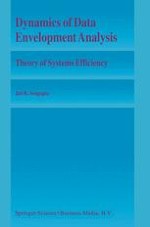1995 | OriginalPaper | Buchkapitel
Entropy, Efficiency and the Index Numbers
verfasst von : Jati K. Sengupta
Erschienen in: Dynamics of Data Envelopment Analysis
Verlag: Springer Netherlands
Enthalten in: Professional Book Archive
Aktivieren Sie unsere intelligente Suche, um passende Fachinhalte oder Patente zu finden.
Wählen Sie Textabschnitte aus um mit Künstlicher Intelligenz passenden Patente zu finden. powered by
Markieren Sie Textabschnitte, um KI-gestützt weitere passende Inhalte zu finden. powered by
Measuring productive efficiency of a set of decision making units (DMUs) basically involves the comparison of two sets of distribution of input-output data: one is the observed set and the other the optimal set. The technique of data envelopment analysis (DEA) defines the optimal set in terms of a Pareto criterion of efficiency and uses the positive distance between the two sets as a measure of inefficiency. The DEA approach however fails to incorporate any statistical aspect of the data distribution, e.g., skewness, asymmetry or heteroscedasticity. Farrell (1957) as the precursor of the DEA approach noted in his empirical analysis of the agricultural farms that the statistical distribution of the efficiency measure is highly skewed and also outlier sensitive. Since entropy provides a measure of diversity of the data distribution, it is useful to explore its application in comparing different output distributions.
